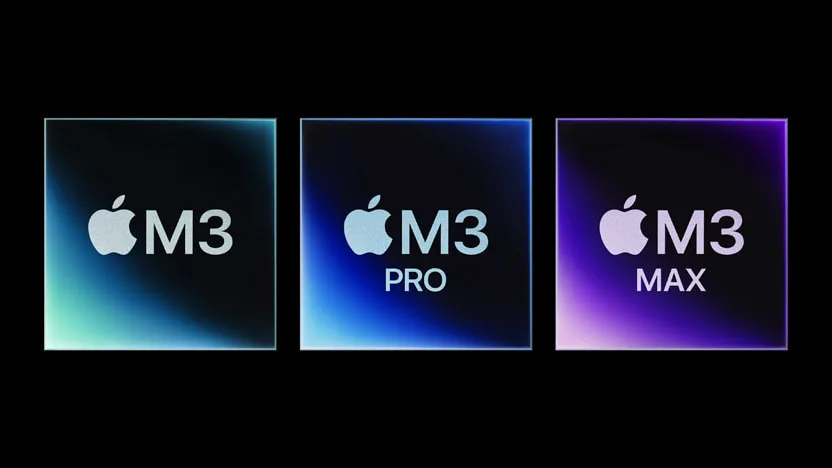Apple M3 series - Apple responds to the competition
Apple has released the Apple M3 series of processors for its lineups of PCs (Macbooks, Macbook Pros, and iMacs). These processors offer a good blend of CPU performance, gaming, and battery life for prospective buyers.
Apple has recently unveiled the Apple M3 series of processors, designed to power their upcoming range of MacBooks and iMacs. This development marks a significant milestone in Apple's strategy to transition from Intel processors to their in-house silicon, initiated in 2021. The M series of processors is integral to Apple's line of computers, including the iMac and MacBook series.
With growing competition, notably from their rival Qualcomm entering the PC market, Apple recognized the need for a swift response. In a noteworthy move, Apple is simultaneously launching six processors:
- Apple M3 (8-core GPU)
- Apple M3 (10-core GPU)
- Apple M3 Pro (11-Core)
- Apple M3 Pro (12-Core)
- Apple M3 Max (14-Core)
- Apple M3 Max (16-Core)
In broader categorization, the M series can be segmented into four distinct lines:
- The base M series
- The M Pro series
- The M Max series
- The M Ultra series
With the introduction of six (6) processors across the M, M Pro, and M Max lines, the anticipation grows for an impending Apple M3 Ultra to further expand this innovative processor lineup in the coming year.
Apple M3
The Apple M3 serves as the foundational processor within this lineup, representing the entry-level M processor and thus offering the most affordable choices. Within this category, two different variants are available. The first Apple M3 variant features an 8-core GPU, while the second M3 variant is equipped with a 10-core GPU.
Except for the GPU specifications, both iterations of the Apple M3 are fundamentally identical. Both are constructed around 8-core processors, which consist of four high-performance Everest cores running at 4.05GHz and four power-efficient Sawtooth cores operating at 2.75GHz. These CPU configurations are complemented by either an 8-core or a 10-core Apple GPU, featuring mesh shading and ray tracing capabilities. Furthermore, both variants support LPDDR5 (3200MHz) RAM, accommodating a maximum capacity of 24GB.
Apple M3 Pro
The Apple M3 Pro, positioned within the midrange tier of Apple's Mac processors, continues the trend of offering two distinct processor variants.
The first variant is the Apple M3 Pro with 11 CPU cores and 14 GPU cores, comprising 5 high-performance Everest cores running at 4.05GHz and 6 power-efficient Sawtooth cores operating at 2.75GHz. This configuration is complemented by a 14-core Apple GPU.
The second variant of the Apple M3 Pro boasts 12 CPU cores and 14 GPU cores. This variant features 6 high-performance Everest cores operating at 4.05GHz and 4 power-efficient Sawtooth cores at 2.75GHz, coupled with an enhanced 18-core Apple GPU.
Both processors in the M3 Pro series feature a substantial 37 billion transistors and support LPDDR5 RAM, offering a capacity of up to 36GB.
Apple M3 Max
The Apple M3 Max processors represent the flagship tier within the series, offering superior performance compared to other Apple processors currently available. While they occupy the apex of the M3 series, it's worth noting that Apple may still introduce an M3 Ultra series in the future.
The M3 Max is available in two distinct variants. The lesser variant features 10 performance Everest cores operating at 4.05GHz, accompanied by 4 power-efficient Sawtooth cores operating at 2.75GHz. This configuration is complemented by a formidable 30-core Apple GPU. These processors support LPDDR5 RAM with a maximum capacity of up to 96GB and are constructed with 92 billion transistors.
The better M3 Max variant is equipped with 12 performance Everest cores operating at 4.05GHz, accompanied by 4 power-efficient Sawtooth cores at 2.75GHz. This variant boasts an exceptional 40-core Apple GPU, recognized as Apple's most powerful GPU to date. Similar to the other M3 processors, the M3 Max supports LPDDR5 RAM, with a capacity extending up to 128GB.
Features
All M3 series processors are equipped with GPUs featuring hardware-based Ray Tracing, dynamic caching, and mesh shading, ensuring proficient handling of games and graphics-intensive tasks.
The CPUs incorporated in the M3 series achieve a delicate balance between processing power and energy efficiency. The memory capacities vary among the processors, reaching maximums of 24GB, 36GB, 96GB, and 128GB, depending on the specific variant.
Each of the processors also features a consistent 16-core Apple Neural Engine, capable of performing up to 16 trillion operations per second (TOPs). Additionally, the processors include an advanced media engine that offers hardware acceleration for various video formats, including H.264, HEVC, ProRes, ProRes RAW, and AV1.
Moreover, all processors within the M3 series support USB 4/Thunderbolt 4 connectivity, further enhancing their capabilities as media powerhouses. These processors are expected to be integrated into Apple's iMac, MacBooks, and MacBook Pros.
Conclusion
The Apple M3 series introduces a range of processors tailored for various performance levels, expanding Apple's capabilities within its Mac product lineup. With exceptional GPU capabilities, advanced CPU configurations, and ample memory support, these processors are poised to offer notable improvements in both processing power and media capabilities.
